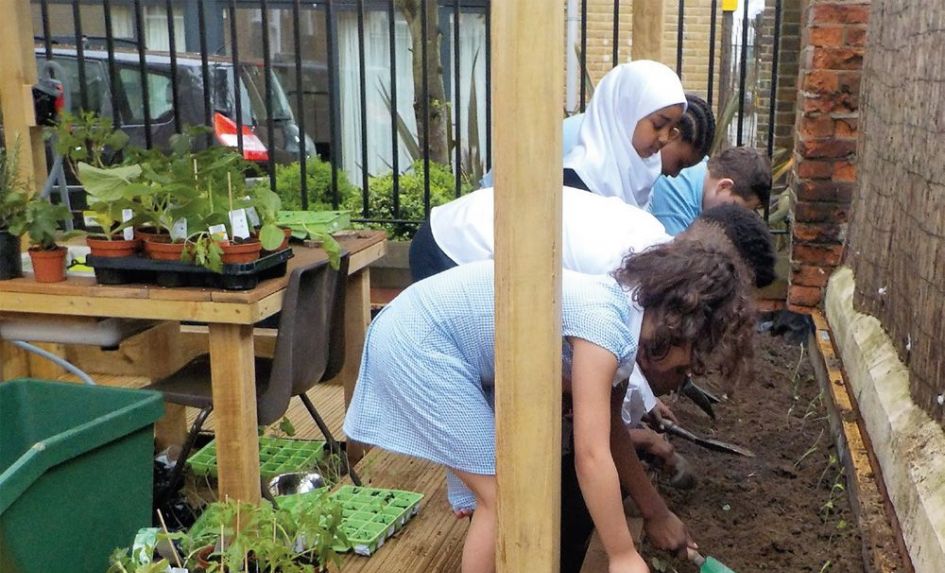Whether you have acres of outdoor space or a small concrete courtyard there’s always something you can do to maximise its potential.
1. BUILD STAFF CONFIDENCE
Taking teaching and learning outside will come more naturally to some teachers than it will to others. Some will have come through initial teacher education routes that don’t provide training in this area, so it may be necessary to provide them with some CPD.
2. ASSESS THE RISK
Using your school grounds to pursue outdoor learning opportunities will involve fewer health and safety risk factors than going off site. Risk assessments should still be carried out for all non-classroom based activities, but you can keep these on file as you re-use them in future.
3. WORK OUT THE COST
Even a bare field or tarmac space will instantly offer access to wildlife, textures, surfaces, sounds, smells and space that can’t compare with a classroom. You can then add elements such as planting facilities for biodiversity study and growing food for a relatively modest investment.
4. EMBED PEDAGOGY
Don’t just use your outdoor space for ‘one-off’ lessons in summer; use it to enhance pupil outcomes all year round by embedding outdoor activities in your school development plan, line management, ongoing CPD, recruitment expectations and appraisals.
5. EMBRACE MULTIFUNCTION
Since the protection of statutory amounts of space per child in was removed in 2012, school grounds have been encroached upon for development, additional classrooms, car parking and other purposes. Make the most of what you have and utilise it to the fullest.
6. CULTIVATE WILDLIFE
Wildlife is attracted to spaces that provide them with the habitats they need to survive. Ensure your growing plots include fragrant fruit and veg that attract pollinators, and you’ll help to attract bird life and insect species, as well as improve the success of your crops.
7. SIT COMFORTABLY
Sawn-off logs and tree trunks are perfect for creating small group teaching spaces, circle time activities or amphitheatre-style seating. They can be left out all year round, stacked away when you need extra space and used in the wet with plastic sheeting.
8. ACCOMODATE YOUR TREES
Start seeing your trees and buildings as lesson resources, rather than objects that just get in your way. Activities involving angles, textures, history and creative writing can encourage pupils to find inspiration in the surrounding built and planted environment.
9. RETHINK YOUR TOPOGRAPHY
If you have the funds to indulge in a little light landscaping, features such as mounds and hollows will increase your square footage and provide rich natural additional learning resources – while also serving as a unique landscape for play and recreation.If you have the funds to indulge in a little light landscaping, features such as mounds and hollows will increase your square footage and provide rich natural additional learning resources – while also serving as a unique landscape for play and recreation.
10. MAKE IT ACCESSIBLE
Include a transition space where pupils can remove coats and muddy boots before entering the clean corridor; place an outdoor water tap in a convenient place to avoid the need for repeated traipsing; invest in a small shed for storing frequently used outdoor lesson resources.
“OUR CLASSES ALWAYS GO OUTSIDE” HEADTEACHER MARGARET JOHNS RECALLS HOW AN OVERHAUL OF HER SCHOOL’S HITHERTO EMPTY OUTDOOR SPACE HAD A TRANSFORMATIVE EFFECT ON PUPILS’ LEARNING OUTCOMES AND BEHAVIOUR…
Located in Livingston, St John Ogilvie RC Primary School has 14 classes and a school roll of approximately 380, with a further 70 pupils attending its nursery. Around two years ago it was invited by West Lothian Council to apply for funding from the charity Grounds for Learning to improve its outdoor space, and was among five successful applicants chosen from 26 other schools.
ADRESSING AN URGENT NEED
“I’d been in the school for about a year and a half, and recognised that we urgently had to do something with our playground. We had some grass, but it was essentially a vast expanse of tarmac and not very appealing. We now have a hill that’s had a huge impact both visually and in terms of possibilities for adventurous play. We’ve also had some constructions put up and a huge sandpit built at the bottom of our playground. There were initially some risk assessment issues to take care of, but our LA’s experts were able to assist us with that.”
MAINTAINING MOMENTUM
“We then decided to apply to our LA to adopt a piece of local woodland just outside of our grounds. We wanted to maintain momentum and ensure we were expanding our ability to offer a more organised and progressive outdoor learning pathway. An outdoor learning development officer joined us, and many of our staff volunteered to do Forest School training. We’re now able to offer different learning opportunities for children who find classroom learning difficult, and our grounds are being used for outdoor learning CPD by other nearby LAs.”
POSITIVE FEEDBACK
“Our staff training initially focused on our pupil support workers. After a couple of months they became strong advocates of the new space and helped bring our teachers round to the idea of moving lessons outside. I can see which classes will be working outside that day, because they’ll be wearing their wellies and waterproofs – classes will always go outside, regardless of the weather. We’ve had positive feedback from parents, and seen positive changes among pupils in terms of their playground behaviour and interactions between age groups”










